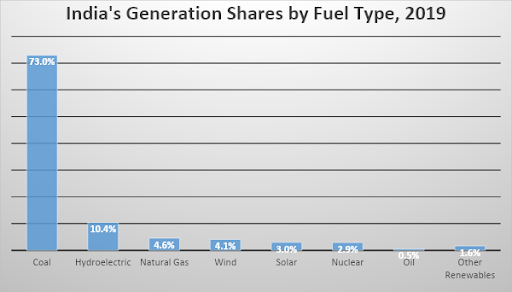India’s wind generation fell by 43 percent in July, surprising the industry as the monsoon season has been optimal for wind generation in the past. Led by wind’s reduction, India’s total renewable energy generation this July was 24 percent less than July of last year. The primary wind power generating months are from June through September—that 120-day period provides almost 85 percent of the country’s annual wind output. In India, solar power remains productive much longer than wind power—over double the time—at least 280 days per year.
India’s 2019 Generation
By far, India uses coal to generate most of its electricity, generating 73 percent of its electricity from coal in 2019. (See graph below.) India’s non-hydroelectric renewable generation made up just 9 percent of its generation in 2019—up one percentage point from 2018. Generation from all non-hydroelectric renewables was less than that from hydroelectric power, which was 10 percent of generation in 2019. Wind generation totaled 63.3 terawatt hours and was 4 percent of India’s total generation, while solar generation was 46.3 terawatt hours or 3 percent of India’s total generation. India had 37.5 gigawatts of wind capacity and 35 gigawatts of solar capacity at the end of 2019. For the first six months of this year, capacity additions for wind have totaled 2,000 megawatts, while for solar, they have totaled 8,000 megawatts.

India’s total installed wind power capacity was the fourth largest in the world in 2019, after China, the United States, and Germany. Its wind power capacity is mainly spread across the Southern, Western, and Northern regions of the country. The data for July showed over a 50 percent drop in wind generation in most Indian states including Rajasthan, Gujarat, and Tamil Nadu. In Andhra Pradesh, wind and solar generation fell for the second year in a row.
Wind speeds have been exceptionally low this year, but it is believed that they will pick up in August and September. Wind speeds have been a worry for the first two months of the monsoon season because the wind speed pattern had changed. The number of days with good wind speed has been decreasing by about a half. However, wind generation in the initial days of August improved somewhat and wind speed is expected to pick up in the second wave of the monsoon season.
Background
Wind power saw a steady growth in India for about three decades—from 1985 to 2015. Most of its 37.5 gigawatts of installed wind capacity were built due to government incentives such as accelerated depreciation, generation-based payments and feed-in tariffs. Electricity is a huge issue in India, where the World Bank estimated in 2018 that 200 million Indians still lacked electricity. India’s economic progress is tied to the electrification of villages and the expansion of economic opportunities which comes with electricity. Therefore, having reliable electricity is very important to the nation.
In 2015, India announced a goal of installing 175 gigawatts of renewable energy by December of 2022. However, of that figure, wind was allocated just 60 gigawatts as the focus shifted to solar power. According to the Union Ministry of New and Renewable Energy, wind projects totaling 13 gigawatts are in the pipeline and another 10 gigawatts are expected to be tendered in the coming months to meet the 60-gigawatt target. However, the industry believes that wind power sector is losing its sheen and that total capacity of wind may only reach 45 gigawatts by March 2022. Its failure to perform during peak season this year may further affect plans for wind.
India has a high wind energy potential—302 gigawatts at 100 meters hub height and 695 gigawatts at 120 meters. Nearly 97 percent of this potential is concentrated in seven states—Gujarat, Karnataka, Maharashtra, Andhra Pradesh, Tamil Nadu, Rajasthan and Madhya Pradesh.
State-Wise Wind Energy Potential, Target and Installed Capacities
Conclusion
While India may have great energy potential in wind, it has allocated only a third of its renewable capacity goal for 2022 to wind. The country recently found that the technology is not achieving the wind speeds that it had in the past, particularly during the monsoon season when 85 percent of wind output is usually achieved. Clearly, wind is not as reliable as coal, which generates 73 percent of India’s electricity.